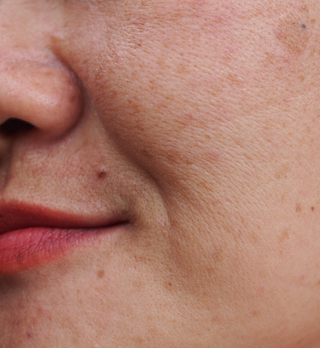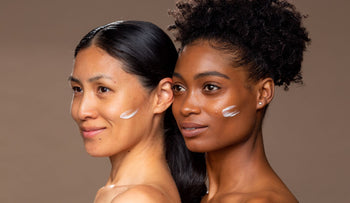Dark spots or pigmentation can happen anywhere on your body, but you may be most concerned about spots on your complexion. Freckles, age spots and even scarring can stand out and cause an uneven complexion, even under makeup.
While spots are not usually an indication of anything serious, it’s a good idea to have regular check-ups with your dermatologist, who can examine them and monitor your skin for any changes. Your doctor will check for a lentigo maligna, which looks like an age spot but is a warning sign for melanoma (skin cancer).
Many people with a concern for dark spots in their complexion are searching for an effective means of reducing their appearance, while others want to prevent them from occurring in the first place. The good news is that there are products today that can help restore your skin to its youthful, even-toned look. Keep reading to find out what dark spots are and how you can prevent them from cropping up in the future.
What causes dark spots on your face?
Dark spots on your face can be the result of a number of different environmental and physical factors, but the main underlying cause is hyperpigmentation, a condition in which the skin produces too much of the pigment melanin. Below are just some of the causes of dark spots on the face, and how you can preserve a bright, spot-free complexion.
Sun exposure
Too much time in the sun, or not adequately protecting your skin from aging UV rays, can speed up the production of melanin, leading to sun spots. Did you know you’re more at risk of developing spots on your complexion if you have a lighter skin tone and are prone to burning easily? Dermatologists recommend protecting your skin from the sun year-round, regardless of skin tone.
Since your face and hands are more often exposed, you’ll probably find that these are your biggest problem areas for hyperpigmentation. To keep yourself protected, try to limit your time in the sun from 10am and 2pm, when the sun is strongest and highest in the sky. Be sure, too, to apply a sunscreen or moisturizer with sunscreen with an SPF 30 or above every day, all year round, even on cloudy or overcast days.
Pollution
You may not be aware of the direct impact that environmental factors such as pollution can have on your skin. Exposure to air pollution caused by exhaust fumes and manufacturing can lead to free-radical damage and inflammation. Then result for your complexion? Hyperpigmentation. Often. particles from pollution are so small that they’re able to become embedded in the skin’s layers, causing pigment-producing cells to go into overdrive, and leading to visible dark spots on the complexion.
One way to prevent pollution-induced hyperpigmentation is to cleanse your skin as soon as you get home each day. By doing so, you wash away pollutant particles before they have the chance to sink in. Products containing antioxidants, like our MULTI CORREXION® Revive + Glow Gel Cleanser, help clear the skin of harmful pollutants and toxins.
Acne
When a pimple finally goes away, you may think your problems are over. But acne can cause pigmentation, even after the skin has healed. This is called post-inflammatory hyperpigmentation (PIH), and is the skin’s natural response to inflammation and damage.
You can avoid dark spots caused by PIH by reducing the opportunity for them to appear in the first place. To keep acne at bay, make sure you’re cleansing your face twice a day, keep makeup brushes clean, and always remove your makeup before bed. While it may be tempting to pick at a blemish, doing so can cause the inflammation to last longer than it otherwise may. Anything that prolongs skin inflammation can increase your chances of post-inflammatory dark spots.
Aging
If you sunbathed frequently without sunscreen when you were younger, you may be surprised by the effect of sunlight on your skin in your 40s. Sun damage is one of the main causes of skin aging because the ultraviolet rays from the sun penetrate into the skin and damage the elastic fibers that keep the skin firm and wrinkle-free.
While you can't go back in time to reduce past sun exposure, you can protect your skin from further damage by following our sun exposure tips above.
How to remove dark spots on your face
The good news is that there are many treatments available for targeting an uneven skin tone. These products contain different ingredients, each with their own benefits and instructions for use.
Vitamin C
Vitamin C is a powerful antioxidant that has been proven to reduce the number of pigmented cells, as well as reverse any damage caused by aging, leading to a reduction in dark spots. Since the body doesn’t produce this essential nutrient on its own, incorporating vitamin C skincare products into your daily routine is the best solution for brightening your complexion and minimizing the look of dark spots.

Retinol
Known for its transformative effects on the skin, retinol is a popular ingredient for reducing dark spots. Products containing retinol work by boosting your skin’s renewal process, which helps to diminish signs of aging on your complexion. Retinol also stimulates collagen production, which is another way it diminishes dark spots. Not only will dark spots be reduced, but wrinkles and sagging skin will also begin to diminish, and the effects of retinol products will continue to work just as effectively over time.
If you have an uneven skin tone, consider treating it overnight. At night, the skin’s cells regenerate fastest due to the increased blood flow to the skin, helping your skin to better absorb topical treatments. Want to treat dark spots while you sleep? Check out our MULTI CORREXION® Revive + Glow Night Serum Capsules. Made with our highest dose of 20% pure Vitamin C, 100% of women saw a visible reduction in dark spots in just 4 weeks.
For skincare tips and advice take a look at our blog, or discover more about hyperpigmentation and how to prevent it.







